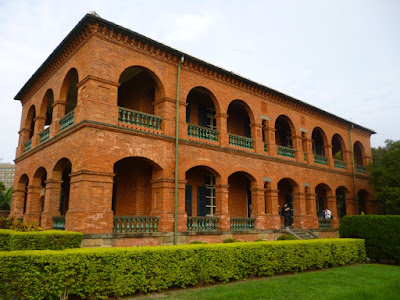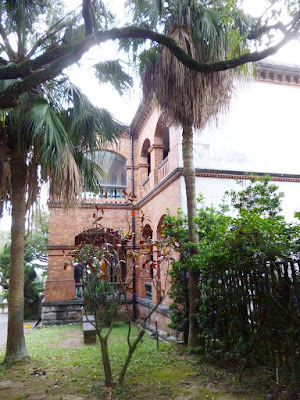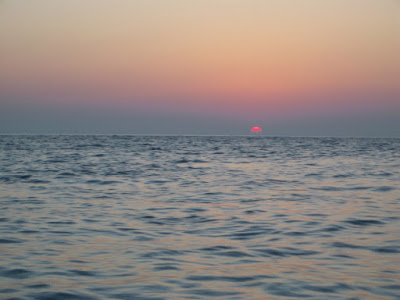 My first visit to Taiwan was
unexpected and entirely unplanned. I’d been working in Beijing and then
Shanghai for over a month in the summer of 2006 when I was suddenly asked to
fly onwards to Taipei to attend a meeting at the National Palace Museum. I had
been due to travel onwards to Tokyo on leave once I’d finished in Shanghai but thankfully
my leave was delayed rather than cancelled in order to accommodate this little
detour. The changes to my travel arrangements all happened so quickly that it
was only whilst I was in transit (i.e. – actually sitting on the plane flying
to Taipei, via Macau, and now coming in to land), when it first occurred to me
that I had no idea whether or not I needed a visa to enter Taiwan! – Looking
back, I don’t suppose they would have let me board the plane had a needed one,
but nevertheless, I still felt a little uneasy as I wandered through the airport
terminal towards the immigration counters not knowing what to expect – but then
I saw a big sign directing (and more importantly listing) the visa exempt
countries to a particular queue. I breathed a huge sigh of relief as it felt
like a minor diplomatic faux pas had
been narrowly averted.
My first visit to Taiwan was
unexpected and entirely unplanned. I’d been working in Beijing and then
Shanghai for over a month in the summer of 2006 when I was suddenly asked to
fly onwards to Taipei to attend a meeting at the National Palace Museum. I had
been due to travel onwards to Tokyo on leave once I’d finished in Shanghai but thankfully
my leave was delayed rather than cancelled in order to accommodate this little
detour. The changes to my travel arrangements all happened so quickly that it
was only whilst I was in transit (i.e. – actually sitting on the plane flying
to Taipei, via Macau, and now coming in to land), when it first occurred to me
that I had no idea whether or not I needed a visa to enter Taiwan! – Looking
back, I don’t suppose they would have let me board the plane had a needed one,
but nevertheless, I still felt a little uneasy as I wandered through the airport
terminal towards the immigration counters not knowing what to expect – but then
I saw a big sign directing (and more importantly listing) the visa exempt
countries to a particular queue. I breathed a huge sigh of relief as it felt
like a minor diplomatic faux pas had
been narrowly averted.
It was around this time too that I
was just getting started on my research into the colonial era in China and
Tibet, and the history of the British Consular Service in China in particular –
hence I was rather intrigued to see the flag of the old Republic still flying
proudly over the airport in Taipei. Indeed, the landing card I had to fill out
was headed ‘The Republic of China (ROC).’ I’d never really thought about this
fact before. I knew this island was where the KMT (Kuomintang) had retreated to
in 1949 when they were ousted following the civil war with the CCP (Chinese
Communist Party), but growing up in the UK it had always been referred to as ‘Taiwan’
and so that’s how I had always thought of it up until that moment. Realising I
still had much to learn this initial trip only served to deepen my curiosity. I’m
sure it was in a large part due to this quirk of fate, working on so many
exhibitions in Asia at this time, that I was drawn deeper and deeper into the
topic which would eventually turn into the research for my current PhD studies.
Indeed this was only the first of many such trips to Taiwan, working on a
number of different exhibition projects with colleagues who have become close
friends at the National Palace Museum. And similarly, several more times
working in Shanghai with good friends at the Shanghai Museum as well. In both
cities I spent my free time exploring the old colonial remnants, hunting out
old buildings from the late nineteenth and early twentieth centuries built
variously by the banks, trading companies, and government officials of America,
Japan, and several different European countries, including Britain. The
colonial building which interested me most in Taipei was the Red Fort at Tamsui
(or Danshui, meaning ‘fresh water’ 淡水).
Tamsui is actually situated some
ten miles or so downriver from the centre of Taipei. It is very easy to reach
on the city’s Metro system, with Tamsui located at the end of the Tamsui-Xinyi (or
Red) line. The last couple of miles of the train ride into Tamsui has some
spectacular views of the river which has stretches of mangrove trees growing
along the water’s edge. Taiwan is the most northerly latitude at which you will
find mangroves. It makes for a wonderful sight with the towering peak of
Guanyin Mountain rising up from the opposite shore. There’s quite a lot of
wildlife to see here too. My friends and I were all mesmerised to see an army
of colourful crabs, each with one enormous claw hand, aggressively picking rather
comical-looking fights with one another in the mud at low tide. Being so close
to Taipei, Tamsui is a popular spot for a day-out at weekends. It has the feel
of a seaside holiday town with souvenir shops, restaurants and cafes lining the
riverside promenade with people strolling along eating ice cream and candyfloss
in the sunshine. Regular boat trips head across the river, and then carry on
down to the point where the river meets the open sea before turning back; you
can hop on and off the boats in order to explore along the way. It was on such
a boat trip that I first caught a glimpse of the Red Fort – rather fittingly,
as this is how most old colonial types would have first seen it when arriving
by steamer, as the Tamsui River was the main northern trading port on Taiwan,
or Formosa, as the island was more commonly known at the time (the principal southern
port being at Takow, or present day Kiaohsiung).
 |
| Red Fort, Tamsui, 1925 |
The Red Fort has a long history
dating back to 1628 when a wooden fort was built here by the Spanish, who named
it Fort San Domingo. The fort was later destroyed by the Spanish shortly before
they quit it in 1642, when conceding defeat in a short battle with the Dutch
who felt that the Spanish were unjustly impinging upon their established trade
interests in the region. The Dutch rebuilt the fort, but this time it was much stronger
and more substantial having been built using brick and stone. The Dutch renamed
it Fort Antonio, after the Governor-General of the Dutch East Indies, Anthony
Van Diemen. Essentially, excepting a few architectural modifications carried
out over the intervening years, it is still this building which stands today.
The government of the Qing Dynasty took over control of the fort from 1683 to
1867. During this period the Chinese added a stone wall to enclose the entire
compound with four gateways (only one of which still survives). The fort became
the diplomatic base of the British at the close of the second Opium War in
1868. The British took on a lease of the site in perpetuity, paying the Qing
government “10 silver coins” a year to use the site as a Consulate (I’m not
sure if that’s ten taels or ten
silver dollars Mex., but I suspect the latter). And it was the British who first
painted it red, however, it had been known as the red fort before this because
the locals had referred to the Dutch as “red-haired people” – previously the
fort had always been painted white. Wandering around the place today it can
feel eerily evocative, especially if you find yourself alone in some of the
long forgotten rooms. The fort and consular residence still have that faded air
and atmosphere of exile characteristic of a good setting for a short story by
Joseph Conrad. It’s easy to imagine stumbling upon a Kaspar Almayer, an Axel
Heyst, or a Lord Jim-type lounging in the humid torpor of one of the back rooms;
a ceiling fan turning languidly overhead as our despondent colonial antihero sits
dosing in an armchair, his head resting on a starched anti-macassar, and the
half-smoked stub of a forgotten cheroot lazily smouldering between his dangling
fingers …
 |
| Consul's Residence, Tamsui, 1891 |
 |
| Consul's Residence, Tamsui, 1911 |
 In 1891 the British upgraded the Consul’s
residence, adding a second storey. Built of red brick it is a classic example
of Victorian-era colonial architecture. Wide verandas with ornate green ceramic
balustrades surround each floor, helping to keep the interior shaded and cool
during the intense heat and humidity of the summertime. It looks very similar
to the old consular residence, built around the same time, which still stands
in the grounds of the British Embassy in Seoul. I had a good view of this old building
from my hotel room during one of my stays in Seoul whilst working on an
exhibition at the National Museum of Korea in 2010 (I was sure I’d taken a
photograph of this building, but if I did frustratingly I now can’t find it!).
We were lucky enough on that trip to get to know the Ambassador and were even
invited to drinks at the Embassy, but delays caused by the eruption of the
Icelandic volcano, Eyjafjallajökull, meant we had to work late in order to get
the exhibition open on time and so sadly we weren’t able to take up his very
kind offer. I was deeply disappointed at the time (and still am actually) as I
was dying to get a closer look at this old consulate building. I was also dying
to know if the Ambassador really would
“spoil us with Ferrero Rocher chocolates” too!
In 1891 the British upgraded the Consul’s
residence, adding a second storey. Built of red brick it is a classic example
of Victorian-era colonial architecture. Wide verandas with ornate green ceramic
balustrades surround each floor, helping to keep the interior shaded and cool
during the intense heat and humidity of the summertime. It looks very similar
to the old consular residence, built around the same time, which still stands
in the grounds of the British Embassy in Seoul. I had a good view of this old building
from my hotel room during one of my stays in Seoul whilst working on an
exhibition at the National Museum of Korea in 2010 (I was sure I’d taken a
photograph of this building, but if I did frustratingly I now can’t find it!).
We were lucky enough on that trip to get to know the Ambassador and were even
invited to drinks at the Embassy, but delays caused by the eruption of the
Icelandic volcano, Eyjafjallajökull, meant we had to work late in order to get
the exhibition open on time and so sadly we weren’t able to take up his very
kind offer. I was deeply disappointed at the time (and still am actually) as I
was dying to get a closer look at this old consulate building. I was also dying
to know if the Ambassador really would
“spoil us with Ferrero Rocher chocolates” too! |
| Herbert Allen Giles |
The red fort and consular residence
at Tamsui were staffed by a number of different consuls through the years, some
more notable than others. The most notable for my family was Sir Alwyne Ogden
who was here for a time in the mid-twentieth century. In 1922 he was the
acting-consul at Chengdu in Sichuan who officiated at the marriage ceremony of
Louis King and Rinchen Lhamo, apparently amidst exploding shells – rather like
the dinner scene from Carry On Up the
Khyber, one imagines! (see here). The most notable resident though was
undoubtedly Herbert Allen Giles, who was Consul at Tamsui from 1885 to 1891.
Giles went on to become the most famous sinologist of his time. He was
Professor of Chinese at Cambridge University for 35 years. His greatest work
was perhaps his modification of the romanisation system of Chinese, originally
devised by Thomas Wade, which remained the standard form until the official introduction
of Pinyin in 1958 by the government of the People’s Republic (mainland China). Use
of the Wade-Giles system persists in the instance of certain well-known
personal and place names, particularly in Taiwan. One of Giles’ sons, Lionel,
also a sinologist, was Keeper of Oriental Antiquities at the British Museum from
1936 to 1940. Another son, Lancelot, like his father before him entered the Consular
Service in China. Soon after joining the Service Lancelot was present at the
siege of the Legations in Peking (Beijing) during the Boxer Uprising in the
summer of 1900 – he wrote a diary of the siege in the form of letters to his
father, which I wrote about for the Royal Asiatic Society in Shanghai’s China Journal (see here). The National
University of Australia holds a fantastic archive of photographs of early
twentieth century China from Lancelot’s family (see here).
The old fort and consular residence
were eventually returned to the authorities in Taiwan by the British Government
in 1980. It has been listed for preservation as a site of important cultural
interest, and following the completion of restoration works in 2005 it has been
open to the public as a museum. I’ve visited it several times since my first
glimpse of it from a boat zipping up the Tamsui River in early 2007. As a
British person it’s quite interesting (and rather amusing) to see the urban
archaeology of what odds and ends HM Government left behind which have been
exhumed and dusted off for display – I was particularly tickled by the “official
chops”, or rubber stamps “supplied for the Government Service” by HMSO, which
the museum now have neatly arrayed in showcases. Even today official stamps very
similar to these ones are still in daily use where I work at the British
Museum! … It’s interesting too that even the Monarch herself got left behind in
this seemingly long forgotten old colonial outpost ... God Save the Queen, eh! – I’m glad though when lovely old buildings
such as this one have been saved and preserved for the future. So often these
days the fate of such historic buildings is that they are knocked down, or
gutted and converted into a swanky bar or restaurant. I wonder what old Herbert
Allen Giles would make of the place now?
Further Reading:
P. D. Coates, The China Consuls: British Consular Officers, 1843-1943 (Oxford
University Press, 1988)
D. C. M. Platt, The Cinderella Service: British Consuls since 1825 (Longman, 1971)

































No comments:
Post a Comment
Comments do not appear immediately as they are read & reviewed to prevent spam.